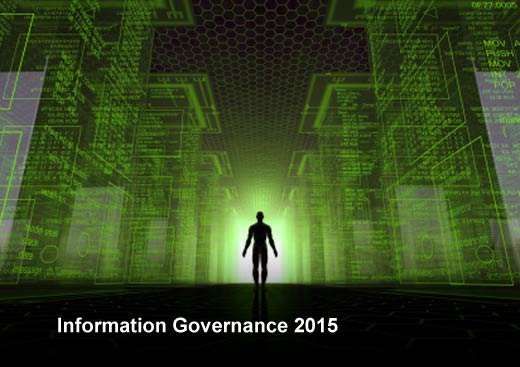In this digital age, it is crucial that corporate documents, both electronic and physical, are governed to ensure that organizations remain fully compliant. As the mountain of information grows, so too does the burden to manage it. With the ever-increasing frequency of electronic communication in the workplace, information governance is a field that will continue to grow and evolve in the coming years.
2014 was a big year for information governance, with records managers embracing the need and driving the transformation from existing records management practices to full information governance in their organizations. Many of the information management conferences and organizations focused their efforts on information governance in 2014 including AIIM and ARMA, as well as the newly formed Information governance Initiative (IGI). AIIM focused one of its Executive Leadership Councils (ELC) on information governance and ARMA jointly staged with the Sedona Conference the first Executive Conference on information governance.
Moving into 2015, organizations must make understanding the value of their information assets a resolution. According to Bassam Zarkout, CTO, RSD, technology alone is not a solution; instead, it must be coupled with cultural changes within an organization in order to implement a successful information governance program. The following slideshow discusses key information governance trends to watch for in 2015.

Click through for eight information governance predictions for 2015, as identified by Bassam Zarkout, CTO, RSD.

Cloud Governance
The movement to cloud is not a new trend – companies have been moving enterprise applications to the cloud for the last five years – with one of the biggest drivers for cloud adoption being file sync and share-based repositories such as Google Drive, Microsoft One Drive, Box and DropBox. While public cloud services offer a variety of benefits to users, they also create a number of obstacles for organizations, as many of these systems don’t offer lifecycle management and governance capabilities. This lack of governance creates critical complications, especially for organizations that operate in multiple jurisdictions, as they must manage the various regulations in each jurisdiction.
In 2015, companies will have no choice but to deploy governance capabilities in the cloud for content that resides in these uncontrolled environments. Executives will need to bring these systems under the corporate governance umbrella while ensuring employees are still able to leverage the capabilities these services provide. At the same time, the information governance steering committees will need to look for easily available tools to begin rolling out the information governance program.

File Analysis Will Be Incorporated into Information Governance Policies
File analysis is an emerging technology that assists organizations in understanding the ever-growing volume of unstructured data they collect, including file shares, email databases and SharePoint sites, as well as some cloud-based file sync-and-share systems. In some cases, file content can be analyzed for personal identifiable information (PII), personal credit information (PCI) and personal health information (PHI) identification.
Organizations will use file analysis to analyze, index, search, track and report on file metadata to enable them to take action on files according to what was identified. File analysis is a key step in an information governance program and precedes the classification and assignment of a policy to enforce lifecycle activities for information assets.
Currently, file analysis is a small and very fragmented market with well-established vendors, as well as dozens of small specialty vendors providing solutions for metadata and content analysis of unstructured data. According to Gartner, much of the market for stand-alone file analysis solutions will be absorbed into more comprehensive solutions within five to seven years, and organizations should use file analysis in conjunction with policy and data retention best practices for a holistic information governance strategy. Based on this, file analysis technologies will become part of all information governance programs in the years to come.

In order to remain competitive, organizations need to digitize their business. Unfortunately, many companies lack the agility to effectively start this process, and do not have the means to do so in accordance with regulations and governance. Consumers are using new mediums to communicate with brands, including social media. In response, marketing departments and customer support groups are using these social media platforms to communicate with internal employees and customers and, in some instances, these interactions represent corporate records.
In Gartner’s report from March of 2013 on the “Six Questions to Drive Records Management in Your Social Initiatives,” it is clearly stated that social media content requires records management, just like all other content, but many organizations don’t know how to create an effective management process. In 2015, more organizations will look to incorporate social media content in their policy definition and explore methods on enforcing the policy across the various systems.

Information is being created at a pace faster than organizations can analyze and extract value from it, which means that the potential value of the information may be far greater than the actual value an organization is able to derive. While corporate executives regularly say, “information is one of our company’s greatest assets,” they rarely truly understand, measure or leverage the total value of that information. In fact, they typically don’t establish value for information assets the way they do for other assets in the organization.
In 2015, organizations will start keeping an internal balance sheet for the valuation of corporate information assets. Without doing so, they perpetuate the misconception that customer information only has value once it’s used, and that customer data sitting idly has no value. Organizations simply cannot afford to ignore the value of their information assets.
Infonomics, introduced and being developed by Gartner, is an emerging theory and practice of recognizing and treating information as a corporate asset. Essentially, the theory of infonomics asserts that information is an actual asset with both potential and realized value that can be quantified, maximized, and managed as an asset. This trend of infonomics or, more generically, the valuation of information assets, will continue to emerge in 2015.

The use of Big Data has been a trend for a while now. At this stage, it is essential that as organizations extract information, they be transparent on how they use the information. With the Internet of Things, location services on mobile devices, website tracking initiatives and other intelligent tools, companies are collecting massive amounts of information about their customers. The question on the table is, how are companies efficiently extracting value from this information (scattered across systems and across formats) and, more importantly, how are they protecting the privacy of the customer?
In 2015, more and more companies are going to look at new and creative tools to analyze the data while ensuring the content is protected and secured according to information governance policies.

New Leaders Will Continue to Emerge
In the last few years, there has been a tremendous uptick in the creation of information governance steering committees; however, there is still a need for an executive in each organization to drive the information governance initiative across their company. This executive must have the authority (and oversight) to manage the program. Remember, information governance is not a one-time project; it is a continuous program that must be backed within the organization and IT infrastructure.
To be successful, this executive must report directly to the CEO and work with all the various stakeholders – legal, records, business and IT. Gartner expects this executive will be the chief data officer, while the Information Governance Initiative (IGI) predicts a new role called the chief information governance officer (CIGO) will emerge. Regardless of what title you place on this person, the individual will drive new standards, controls, processes, disciplines and corporate objectives for the global organization.

We will continue to see new technologies and vendors enter and expand the information governance market throughout 2015. Initially, much of this market will be focused on applying the principles used to manage physical records to electronically stored information. As this has evolved, it has become clear that new technologies are required to handle and automate much of the manual process applied for physical records. Policy management and automated enforcement emerged very early as critical functions to support the volume, variety and velocity of information spread across disparate repositories, technologies and systems.
E-Discovery software emerged to eliminate the manual processes used for paper to provide identification, preservation, collection, processing, review, analysis and production of electronically stored information (ESI) to support the discovery process for litigation. Out of e-Discovery emerged technologies to assist with early case assessment (ECA) and legal hold-notification and processing. More recently, file analysis is emerging to provide organizations an understanding of the ever-growing volume of unstructured data, and help categorize information assets to be governed.
With the recent news of leaks, scandals and hacks, executives are more concerned than ever to protect their data. We’ll no doubt see technologies and vendors emerging, expanding or even changing to ensure that companies can quickly and easily ensure that their data is governed properly. The next innovation remains to be seen, but clearly an information governance strategy will continue to be important for all businesses.
















